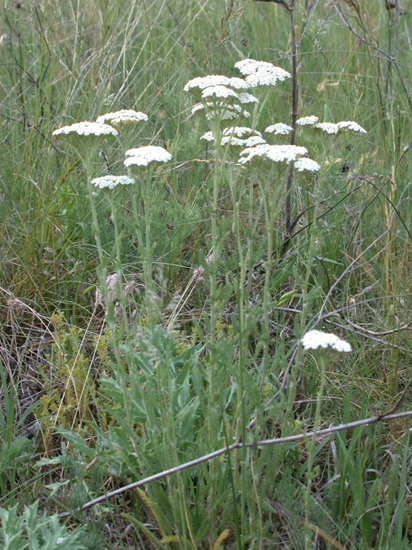Plant descriptions
Achillea collina Becker – Wild yarrow
Achillea collina is a perennial, herbaceous plant in the Asteraceae family/ Asteroideae subfamily (H). Yarrow’s rhizome is located underground, the stems are about 50-80 cm tall and they grow from the rhizomes. The feather-like leaves are located on the stems alternately. The inflorescences are composed from numerous, small florets, the corolla is white. Flowering time lasts from June to late autumn. The small, light brown achenes ripen in autumn, they don’t have topknot. Thousand seed weight: 0.13 g.
Yarrow is widespread in Central- and South Europe, East Asia and North Africa. In Hungary it is also native and common; appears at roadsides, ruderal and fallow places, sunny pastures. Yarrow is a xerophyte, halophyte species with wide ecological tolerance. Often occurs at saline areas, but prefers the warm, sunny places and loose soil types.
The official drug of the plant is the full or cut flowering shoot (Millefolii herba), which is mentioned by the Hungarian Pharmacopoeia VIII. and the ESCOP-monographs. In the practice, the inflorescences collected in full flowering with 4-5 cm long stems (Millefolii flos) are also used. The essential oil (Millefolii aetheroleum), distilled from the fresh plant, is in commercial trade, too. According to the standards of Ph. Hg. VIII. only A. millefolium should be collected, which is a non-azulenic species. To meet the standards (2 ml/kg 0.20 % essential oil and 0.02 % proazulene) other yarrow species from Millefolium aggregate, including A. collina, are collected for the high quality drug material.
The most important active ingredient of yarrow drug is essential oil, which is accumulated mainly in the inflorescences (0.2-0.5 %), the leaves contain lower amount. The main compounds of the oil are sesquiterpene lactones, called azulenes, which are transformed from proazulenes (achillin-, matricin-, artabsin derivates) during the distillation. The azulenic oil is dark-blue. Furthermore yarrow contains other non-volatile sesquiterpene bitter substances and flavonoids (apigenin- and luteolin glycosides).
The herb’s pharmacological effect is scientifically proved in several areas: digestive, spasmolytic, inflammatory, analgesic, antibacterial, and antiseptic. The infusion of the herb is indicated for curing the loss of appetite, gastritis, liver-, gall- and gastric-disorders and cramps. Externally, in form of sitting-bath, it is suggested for healing infections of female reproductive organs or in form of compress or ointments, indicated for curing skin inflammations and wounds. In some cases yarrow caused contact dermatitis at sensitive people.
Anethum graveolens L. – Dill
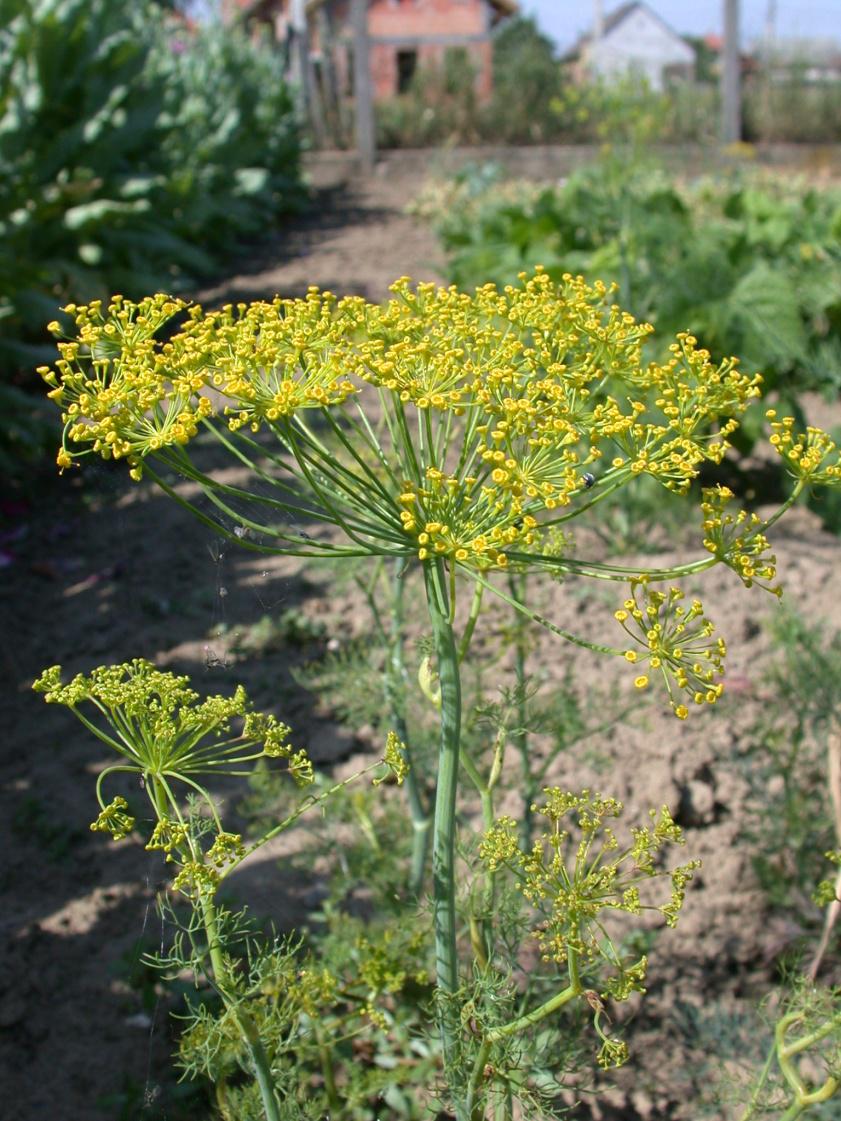
Anethum graveolens is a short-lived annual herbaceous plant in the Apiaceae family (Th). The plant is 40-150 cm tall, the leaves are alternate, finely divided, softly delicate, thread like. The flowers are yellow, located in small compound umbels (2–9 cm). The flowering time lasts from May to July. The seeds are 4–5 mm long and 1 mm thick, straight to slightly curved. Thousand seed weight: 1-2 g, cultivars with both small and big seed size are known. The fruit ripening lasts for a few weeks.
Dill originates from the Eastern coast of the Mediterranean Sea, native to West Asia, Persia, East India, Caucasus and Egypt. In Hungary, it is cultivated, but doesn’t occur widely. The germination of the seeds starts in low temperature (at 8-10 °C), but needs warm, sunny weather in the generative phases of plant development. Dill prefers soils with high water holding capacity and warming potential.
Almost all the organs of dill are used: the overground parts of the plant, before the stems have grown, are cut and consumed freshly or dried (Anethi herba). The ripe fruits of the plant are used as an important spice (Anethi fructus). Essential oil is distilled from the overground parts and the ripe fruits of dill: Anethi herbae aetheroleum (dill herb oil) and Anethi fructus aetheroleum (dill seed oil).
Every organ of the plant contains essential oil in different amounts (the overground parts: 0.8-1.6 %, the mature fruits: 2-4 %). The main volatile compound of the oil is d-carvone. The herb oil contains 25-35 % carvone, while the seed oil accumulates it in a higher amount: 40-60 %. D-(I)-phellandrene (about 20 % in the herb oil) and d-limonene (10-40 % in the seed oil) are also remarkable constituents. The fruits contain flavonoids (kaempferol), dillapiole and fatty oils (15-20 %) too.
The herb and the essential oil of the plant has a pleasant flavour, both are used as spice or preservative in the food-industry and in the household. The volatile oil of dill is an important material for cosmetic industry, too. The fruits can be used as a carminative and have bacteriostatic effect, while water extract of the overground parts has a sedative effect. The seed oil has analgesic activity too; dill can be used for curing flu, because of its immunstimulant and antiviral effect.
Calendula officinalis L. – Pot marigold, common marigold

Calendula officinalis is a herbaceous, annual plant belonging to the Asteraceae family/ Asteroideae subfamily (Th). The plant is 40-60 cm tall with branched stems; the roots are pale-like. The leaves are oblong, lanceolate, slightly serrulate. Marigold has solitary terminal inflorescences with 3-6 cm diameter, the disc florets have an intense orange-yellow colour. The fruits are thorny curved achenes, thousand seed weight: 8-12 g.
Calendula officinalis is native to the coasts of Mediterranean Sea and the Western part of Asia. In Europe it is cultivated since the 12th century. In Hungary marigold is also a popular medicinal, ornamental and dyeing plant, cultivated in the whole country. It can be grown easily in sunny, warm places in most kind of soils. Marigold has a high drought tolerance, too.
Marigold’s drug is the chopped or whole flowers separated from the receptalces, harvested in full flowering (Calendulae flos). It is mentioned in Hungarian Pharmacopoeia VIII. and in ESCOP- and E-monographs as well. To meet the standards of the pharmacopoeia, the drug should contain 0.4 % flavonoid (hiperoside).
The main active substances of Calendula officinalis are water soluble flavonoids (0.04-0.10 %) and lipophilic, yellow-orange carotinoids (3 %, beta-carotene, luteine). Furthermore the plant contains saponins, sterols, essential oil (0.1 %, major component is alfa-cadinol) and polisaccharids (15 %). The fruits of marigold have high fatty oil content with calendic acid as main compound.
The water extract of the herb is immunstimulant, anti-inflammatory, antibiotic, bactericid, antiviral. Internally, as a tea, it is consumed for curing gastric and duodenal ulcers. The oil extract of marigold has an epithelising, skin regeneration stimulating effect. Externally, it used for healing wounds, varicose veins, skin lesions. The cold-pressed fatty oil of the fruits have anti-inflammatory effect as well. In organic horticulture marigold is planted to keep away nematodes and the extract of the plant is used for its mollucicide and allelopathic activity.
Carum carvi L. – Caraway or Persian cumin
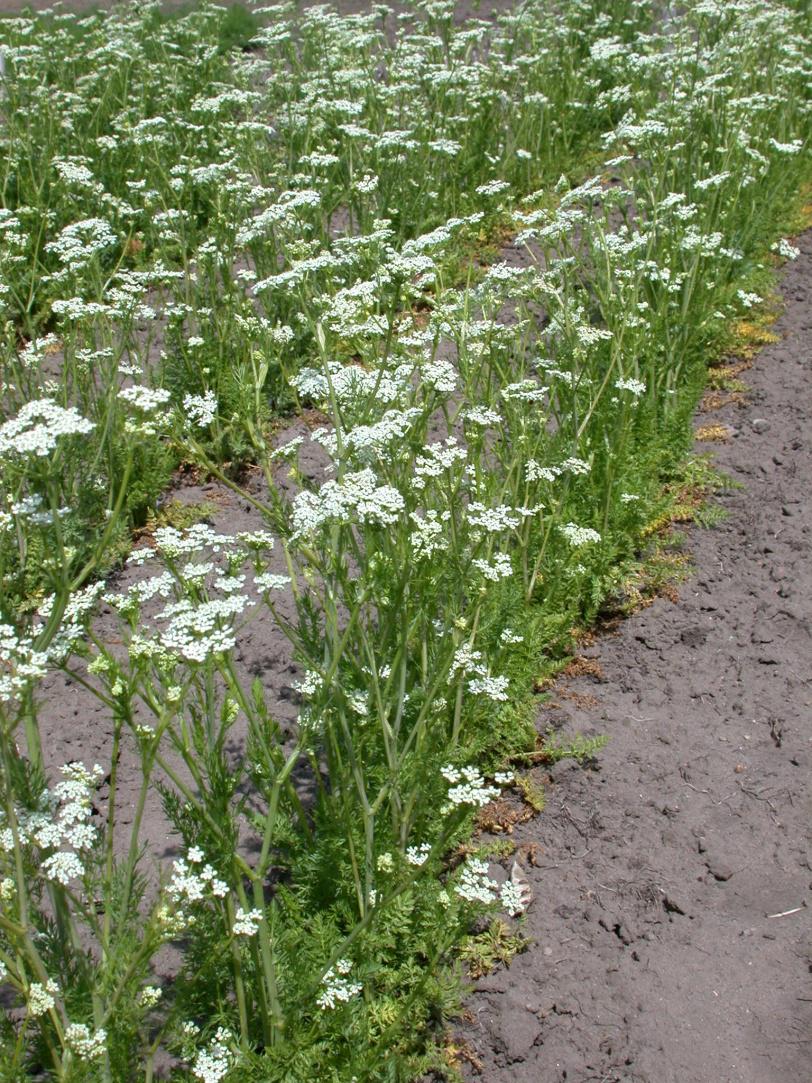
Carum carvi is a herbaceous plant in Apiaceae family (Th-TH). Annual (C. carvi var. annuum) and biennial varieties are (C. carvi var. biennis) also known. Biennial caraway has a long, pale-like, thick root; the stem is branched, erect, 60-80 cm tall. In the first growing season only the leave-rosettes develop over the ground surface. The leaves are trifoliate-pinnate with long stalks (about 20 cm). The flower stems grow in the second growing season after winter. The inflorescences are compound umbels, the petals are white. The caraway fruits are light brown crescent-shaped achenes with five pale ridges. The achenes are 3-7 mm long, 1-1.25 mm wide, thousand seed weight: 2-3.5 g. The annual caraway has less branched, shorter, thinner roots. The leaves are light green, the flower stems are 80-100 cm tall, grow in the year of sowing. The inflorescences are the same with the biennial type, but the fruits are bigger: 5-9 mm long, 1.2-1.5 mm wide. Thousand seed weight: 2.5-4.0 g.
Carum carvi is Eurasian floral element. The biennial variety is native to Central-, North Europe and to the highlands of Asia; in Hungary it is also common. It prefers humid climate, cultivated in Finland, Netherlands, Poland. The annual variety prefers warmer climate, native to the Eastern coast of Mediterranean Sea. Both varieties produce big yields only on high quality, nutrient-rich, calcic soils.
Caraway’s drugs are the dried fruits of the plant (Carvi fructus) and the essential oil distilled from the ripen achenes ( Carvi aetheroleum). The drugs are mentioned by the Hungarian Pharmacopoeia VIII. and in the ESCOP-monographs too. For high quality drug the pharmacopoeia requires at least 30 ml/kg carvone-like essential oil content in the crude drug.
Caraway contains essential oil in 2-7 % with d-carvone as main compound (50-70 %). Other components of the oil are d-limonene, dihydrocarvone, carveol and dihydrocarveol. The fruits contain 20 % protein, 10-18 % fatty oil and 15 % saccharoids too.
Spasmolytic, carminative, digestive, antibacterial and antifungal activity of Carum carvi has been proved. The drug is often applied internally in form of teas, tea mixtures for curing gastric disorders, cramps and distension. Caraway fruit is a popular spice in the food industry, but also an important cosmetic material. The application of the essential oil is perspective as a biological pesticide, because carvone has an inhibitor activity on seed germination and sprouting of bulbs.
Coriandrum sativum L. – Coriander, Chinese parsley
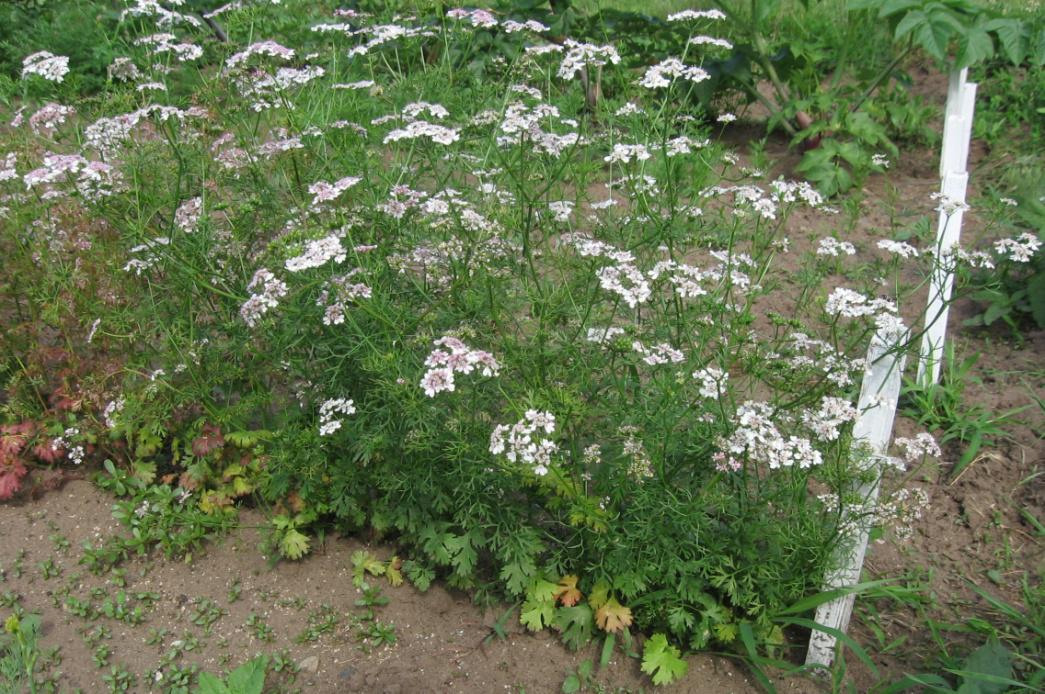
Coriandrum sativum is an annual, herbaceous plant belonging to the Apiaceae family (Th.) Two varieties are known worldwide, both cultivated. The Moroccan coriander (C. sativum var. vulgare Alef. ), which has large (3-6 mm) achenes, is rare in Europe. The other variety with smaller fruit size (1.5-3 mm) is C. sativum var. microcarpum DC., which is cultivated through Central- and Eastern Europe. The roots are branched, pale-like; the stems are 20-150 cm tall. The leaves are variable in shape, broadly lobed with long stalk at the base of the plant, and thin, feather-like upper on the flowering stems. The flowers bloom in compound umbels, the petals are pale pink, the plants start flowering in the beginning of June. The fruit is light brown, globular, dry schizocarp. Thousand seed weight: 5-7 g.
Coriander originates from the Eastern Mediterranean. The plant development is effected by temperature: for the seed germination 15 oC is optimal, but the vegetative development is better on low temperature. During the seed ripening 18-19 oC is needed. Coriander grows easily on soils with high water capacity.
The ripe fruit of the plant (Coriandri fructus) is official in the Hungarian Pharmacopoeia VIII. The high quality drug contains at least 3 ml/kg essential oil according to the standards. The essential oil of coriander (Coriandri aetheroleum) is in trade, too.
Every overground part of the herb accumulates essential oil (fresh shoots 0.036 %, fruits 0.38 %). The main components in the shoots are linalool, decen-(2)-al, dodecen-(2)-al, in the fruits linalool is dominates. The ripe achenes accumulate fatty oils, proteins, vitamin A and C, gamma sytosterin, flavonoids and triterpenes as well.
Coriander drug is efficient in healing digestive disorders, distension and loss of appetite. It has been used for a long time and is an important compound of galenicums. As a spice, coriander is a popular material of canning industry; the essential oil is also used in the food and cosmetic industry.
Cucurbita pepo L. subsp. pepo convar. pepo var. styriaca Grebensc. – Styrian oil pumpkin
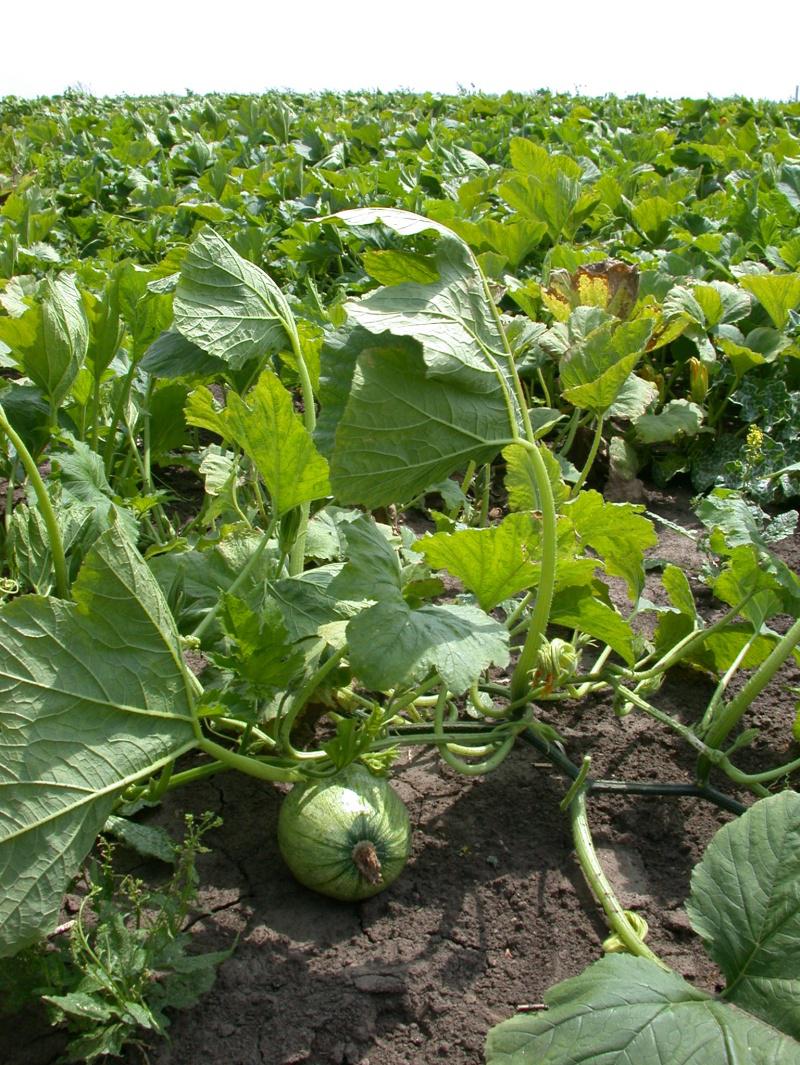
Styrian oil pumpkin is a herbaceous, stoloniferous annual plant in Cucurbitaceae (Th). The roots are thick, placed deeply underground. The stems are hollow, covered with hair, 3-5 m long. The leaves are big, 5 fold lobed, green or sometimes greyish. The leafstalks are 25-30 cm long, hollow and covered with hair, too. The plant is monoecious, the male and female flowers are separated. The petals are yellow, inseparable. The female flowers have short, while the male flowers have long flower stalks. The fruits are medium sized, globular or oblong, yellow with white banding. The fruits contain about 400-500 seeds, which are plain, oval, 15-20 mm long, 8-10 mm wide, 2.5-3 mm thick, olive green or greyish green coloured. Thousand seed weight: 200-310 g.
Styrian oil pumpkin has been known only since the 50s, probably the speciation is caused by a spontaneous mutation. In Hungary the plant has been cultivated since 1976, it originates from the southern part of Austria. Oil pumpkin prefers direct sunlight and warm climate, also has high drought tolerance. It grows well on every soil types, but produces bigger yields on sandy and pise soils, rich in nutrients.
The ripe seeds (Cucurbitae semen) and the fatty oil squeezed from the seeds (Oleum cucurbitae) are the official drugs of oil pumpkins, mentioned by the E-monographs.
Cucurbitae semen’s main active substance is fatty oil (40-60 %), which contains polyunsaturated fatty acids and their derivates: linolic acid (45-50 %), vitamin E-vitamin (over 30 mg %).
The polyunsaturated fatty acids of oil pumpkin (linolic, linolenic acids) are precursors of prostaglandins. The seed and seed oil is a natural provitamin source and also has antioxidant activity, because of the vitamin E and selenium content. The fatty oil of the seeds is efficient against prostate hypertrophia and urinary problems.
Digitalis lanata Ehrh. – Woolly foxglove
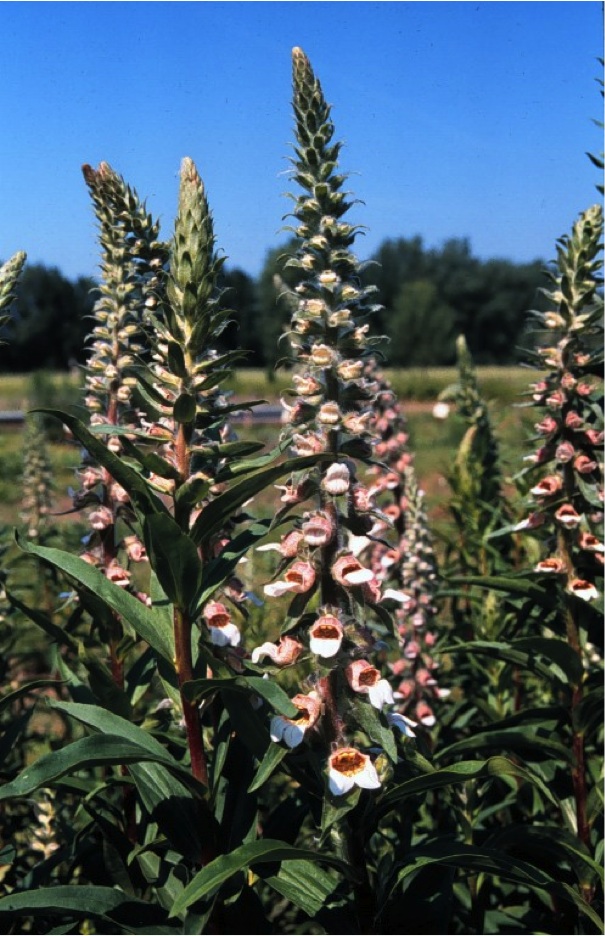
Digitalis lanata is a biennial, herbaceous plant in Plantaginaceae family (TH). In the first year of the vegetation only leaf rosettes develop, which are 15-30 cm long, lanceolate and glossy. The flowers bloom in the second year, the flower stems are 80-120 cm tall the leaves are alternate, acute, lanceolate and they don’t have stalks. The thimble-shaped flowers are located in loose, terminal racemes, the petals are white with brown netting, the bracts and sepals are covered with woolly hair. The flowers bloom in the beginning of June. The small, reddish brown seeds develop in pods that have small hooks. Thousand seed weight: 0.4-0.5 g. From the closely related purple foxglove (Digitalis purpurea) Digitalis lanata can be easily distinguished by the different morphological features: woolly, wrinkled, oval leaves, purple flowers in terminal racemes.
Woolly foxglove distributed through South-Eastern Europe, in Hungary it can occur wildly: several populations are known in Buda hills and in Mecsek. The plant grows well in dry, warm places. The natural populations of Digitalis lanata are highly protected; the commercial drug can originate only from cultivated plants.
The official drug of the plant is the dried leaf: Digitalis lanatae folium. The quality requirements are written in the Hungarian Standards (MSZ 19855-1968), the drug is also mentioned by the German Pharmacopoeia (DAB 9).
The active agents of woolly foxglove are cardenolides (triterpene steroids): lanatoside C glycoside and its aglycon digoxigenin, which is responsible for the biological activity. The whole plant accumulates cardenolids, but the leaf rosettes have the highest steroid content (0.2-0.6 %). Flavonoids and saponins are also active agents of the drug.
Digitalis lanata has been applied for treating poor cardiac functions for a long time. The drug is an important material for pharmaceutical industry, several medicaments are made from digoxigenin (¢Digoxin¢, ¢Isolanid¢, ¢Neoadigan¢). These medicaments can be applied only with constant, medical control. The overdoses can cause toxic symptoms, such as nausea, visual disorders or rare pulse. During the utilization of foxglove medicaments breaks should be kept in application, because both the steroid glycosides and the aglycones can cumulate in the body.
Echinacea spp. – Coneflower species

Echinacea purpurea (L.) Mönch – Purple coneflower
Echinacea angustifolia DC. – Narrow-leaved coneflower
Echinacea pallida (Nutt.) Nutt. – Pale coneflower
Echinace a species are perennial, herbaceous medicinal plants belonging to Asteraceae family/Asteroideae subfamily (H). Purple coneflower is easily distinguishable from the other two species by its morphological features. Narrow-leaved and pale coneflowers are quite similar, they can be differentiated properly only in flowering time. The roots are placed deeply under the soil surface; the rhizome is short, vertical. The stems are 100-150 cm tall, branched, the whole plant is covered with hair. The leaves are lanceolate, oblong-oval, the margins are serrulate. The flowers stand in big, terminal inflorescences, the disc florets 2-9 cm long, 0.5 cm wide, light purple-purple colored. Flowering time: June-September.
The coneflower species originates from North America. Az E. purpurea is distributed in humid regions, while E. angustifolia and E. pallida are frequent on dry prairies. Coneflowers prefer direct sunlight and warm climate, they are frost-tolerant.
The dried flowering shoot (Echinaceae purpureae herba, Echinaceae angustifoliae herba, Echinaceae pallidae herba) and the dried root (Echinaceae purpureae radix, Echinaceae angustifoliae radix, Echinacea pallidae radix) are the drug of coneflower species. Echinaceae purpureae herba, Echinaceae purpureae radix, Echinaceae angustifolia radix and Ehinacea pallidae radix are mentioned by the Hungarian Pharmacopoeia, and ESCOP-monographs. According to the requirements the quality drug contains 0.2 % (Echinacea pallidae radix), 0.5 % (Echinaceae angustifoliae radix) echinacoside. The caffeic and cichoric acid content is 0.1 % in Echinaceae purpureae herba and 0.5 % in Echinaceae purpureae radix.
The main active agents of coneflowers are caffeic acid derivates, alkyl-amides, polysaccharids and essential oil. There are differences between the species by their active substance content. They are also accumulate flavonoids, polyacetylenes, alkaloids (such as toxic pyrrolizidine alkaloids) in a small amount.
The coneflower drug is efficient for treating cold, or chronic diseases of upper-respiratory or excretory organs. The consumption of Echinacea medicaments is also important in disease prevention because of its immunstimulant activity. Externally it is used for curing wounds, ulcers.
Hippophaë rhamnoides L. – Common sea-buckthorn
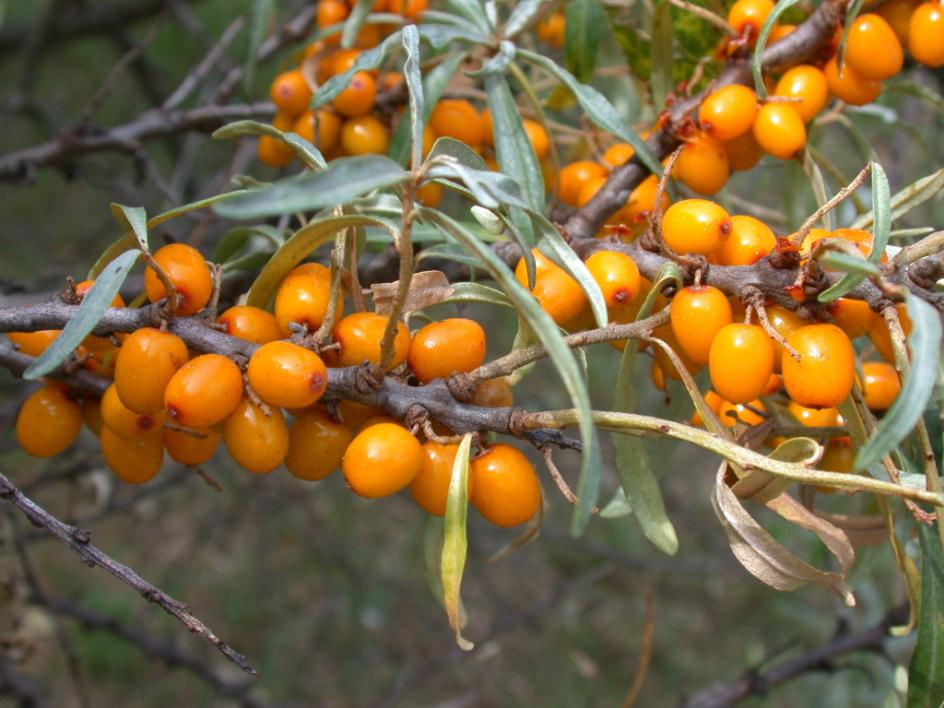
Hippophaë rhamnoides is a deciduous shrub or tree in Elaeagnaceae family. It develops long tap-root, while the lateral roots are placed shallow underground. Shoots can occur from root sprouting too. The branches are covered with silver shiny hair and sharp thorns. The leaves are alternate, narrow, lanceolate, 4-6 cm long, 0.5-1.0 cm wide, covered with hair too. The margins are entire. Common sea-thorn is dioecious, wind-pollinated. The flowers appear on the two-year-old shoots before the foliage. The male florets are small, green, almost invisible, while the female flowers stand in thick racemes or spikes on the upper part of the shoots. The plant can be harvested from the 3rd-5th year. The fruit is orange, globular-oval with 6-8 mm diameter, ripening from the end of September. The seeds are dark brown; the thousand seed weight is 18-20 g.
Hippophaë rhamnoides is an Eurasian floral element, the species is distributed widely in the Northern hemisphere’s moderate and semi-tropical regions. The plant prefers sandy soils, riversides and seashores. In Hungary common sea-thorn is also native, the natural populations are protected. In the cultivation several Altaic cultivars are known, with big fruits size and without thorns. The drought-tolerance of the plant is very high, it can occur even on saline areas. This is caused by the plant’s developed root-system and with the symbiosis of the roots with actinomyces bacterium species. Sea-thorn needs direct sunlight, but has a very good frost-tolerance, too.
The mature fruit (Hippophaë fructus) and the fatty oil, pressed from the fruits and seeds (Oleum hippophaë) are the drugs of sea-thorn.
The Hippophaë fructus contain 75-80 % juice, with saccharides (2-4 %), organic acids (mainly malonic acid) and fatty oil (1-2 %) as main compounds. Furthermore the fruits contain vitamin C (0.15-0.3 %), carotinoides (0.01-0.015 %), vitamin B, E, F, microelements (Ca, Mg, Zu, Ti), amino acids (cysteine, phenyil-alanine). The seeds accumulate 12-15 % fatty oil, rich in unsaturated fatty acids: linolic acid and linolenic acid. The fruits oil is containing saturated fatty acids.
Sea-thorn fruit is an important source of vitamin C. The fruits are used mainly by the food industry, while the seed oil is utilized by the pharmaceutical and cosmetic industry: it is used for healing damages of outer and inner epithels, such as wounds or ulcers, or curing radiation sickness. The fruit and leaf extract has antioxidant activity.
Lavandula angustifolia Mill. – Common lavender, true lavender
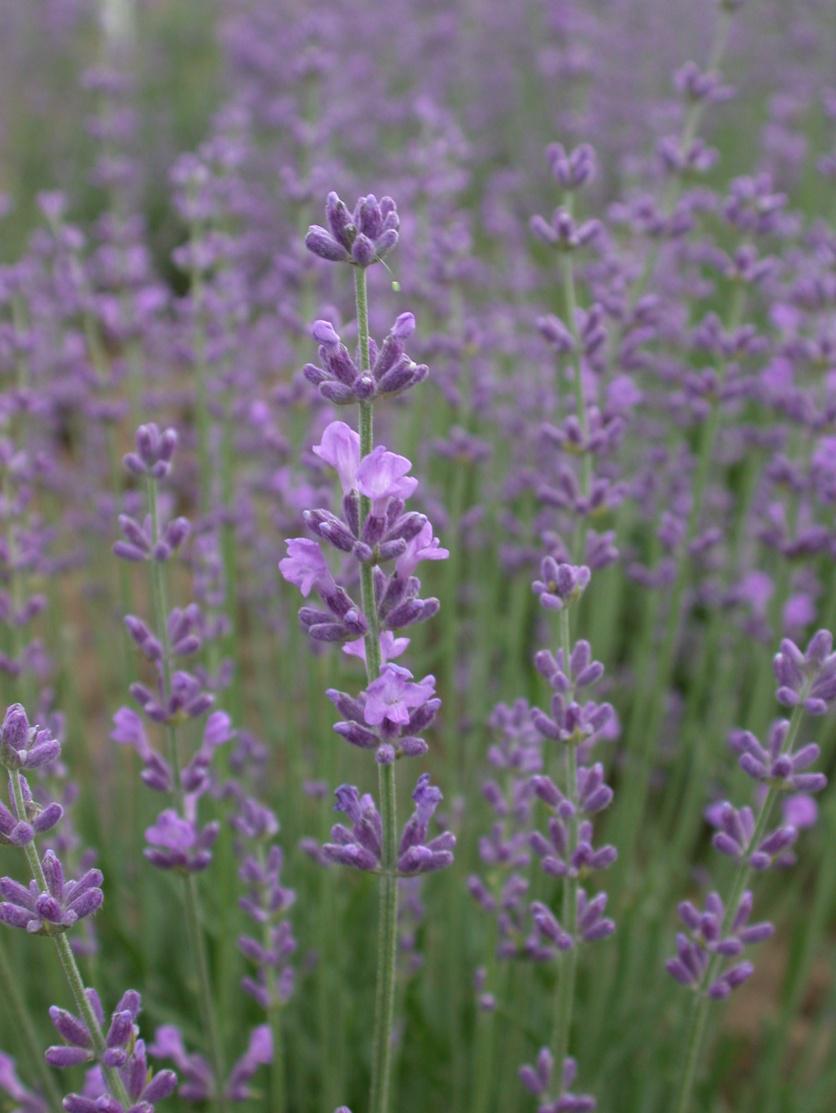
Lavandula angustifolia is a perennial aromatic shrub in Lamiaceae family (N). The roots-system is wooden, branched. The short, thick, warted stem is also wooden above the soil. The shrub is branched, globular, 40-60 cm tall, 80-120 cm in diameter. The flower stems are 20-40 cm long. The leaves are opposite decussate, linear, lanceolate, 3-5 cm tall, 0.2-0.5 cm wide, greyish-green, covered with hair densely. The flowers bloom from the end of June until July. The purple flowers stand in loose spikes on the end of the flower stems. The fruits are 1.8-2.2 mm long, oval, dark-brown or black, shiny. Thousand seed weight:: 0.85-1.1 g. The closely related Lavandula x hybrida is also cultivated for essential oil production. The whole plant is bigger than Lavandula angustifolia: the shrub is 80-100 cm tall, 150 cm, the leaves are longer (5-7 cm) and wider (0.8-1 cm), the flower stems are branched and 60-90 cm long, the colour of the florets is greyish-purple. The plant is covered with hair finely.
True lavender is native to the coasts of Mediterranean Sea, distributed through South, Central Italy, South France, Spain. The first Hungarian plantation was made in Tihany in 1920 by Gyula Bittera. Lavender has high drought tolerance, it prefers dry, calcic soils and warm climate.
The dried flowers (Lavandulae flos) and the essential oil distilled from the fresh flowers (Lavandulae aetheroleum) are the official drugs of true lavender. Both mentioned in Hungarian Pharmacopoeia VIII. Sometimes the floral stems are also used (Lavandulae herba). According to the requirements the flowers have to contain at least 13 ml/kg essential oil, while the essential oil main compound has to be linalyl acetate (25-47 %).
True lavender’s most important active agent is essential oil (0,5-3 %) with linalyl acetate (30-60 %) and linalool (20-50 %) as main compounds. Lavandula x hybrida flowers accumulate more essential oil (0.9-5 %), but the volatile compounds amount is different (only 7-30 % linalyl acetate, 25-45 % linalool). The herb also contains the derivates of cinnamic acid, tannins, coumarins, flavonoids and sterols.
Lavandulae flos has sedative, cholagogue, antibacterial effect. The infusion of the drug is applied in sleeping disorders, nervousness, dissention, gallbladder problems. The volatile oil is used externally in form of ointments or alcoholic extracts for curing rheumatism and neuralgia. Lavender oil is one of the most important material of cosmetic and fragrance industry.
Levisticum officinale Koch. - Lovage
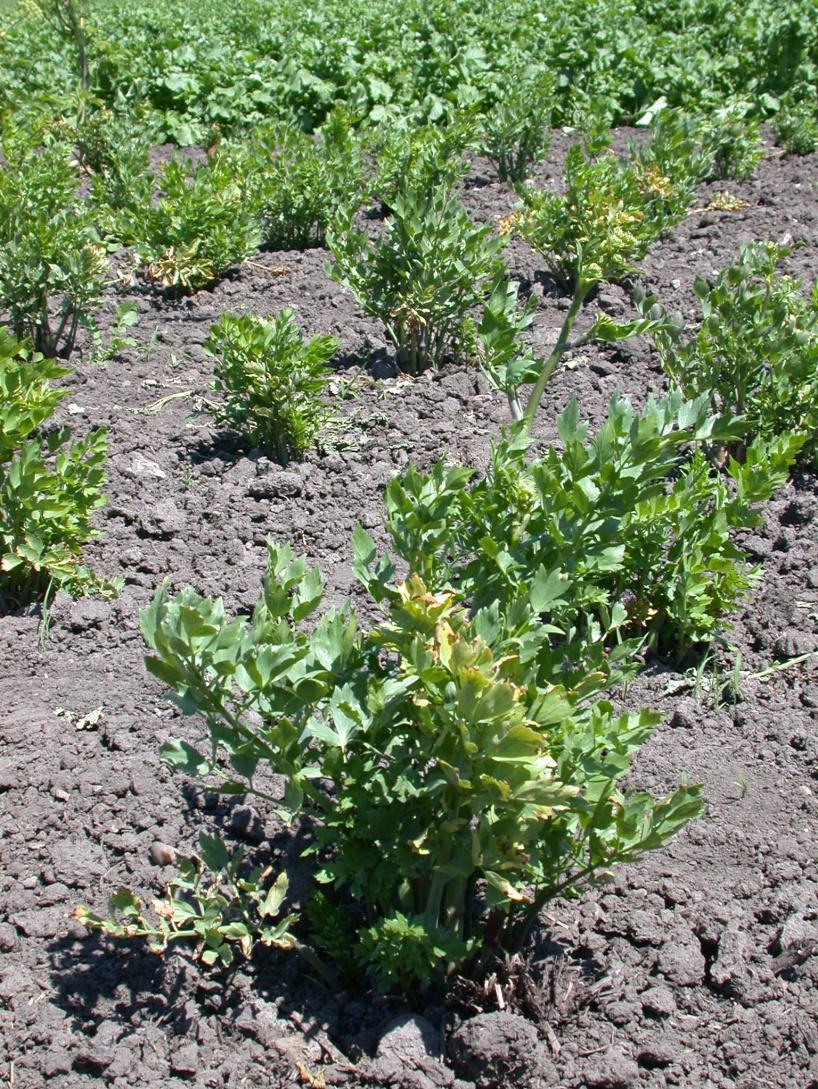
Levisticum officinale is a perennial, herbaceous aromatic plant in Apiaceae family. The root is thick, vertical with a pale-like rhizome, the lateral roots are 15-20 cm long. The root surface is yellow or light-brown, while the fracture surface is white. In the first year of vegetation only the basal leaf rosette appears. The leaves are pinnated, the leaflets are pointed, the marginal is serrulate. The 1.5-2.0 m tall, hollow flowers stems develop from the second year. The stems and leaves are shiny, dark-green to yellow-green. The stem-leaves are smaller and less divided with few leaflets. The flowers are yellow, produced in globular, compound umbels, bloom from the end of June to middle July. The fruits are yellow-brown, flat with three rips on them. Thousand seed weight: 3-4 g.
Lovage originates from South and West Asia, but it is also distributed through Europe and mostly occurs on wet habitats. In Hungary lovage is cultivated, in Békés county. It prefers warm climate and soils rich in nutrients.
The whole or cut root and rhizome of lovage is the official drug in Hungarian Pharmacopoeia VIII. (with 4 ml/kg essential oil in whole drug, 3 ml/kg in cut drug). The essential oil (Levistici aetherolum), the leaves (Levistici folium) and the ripe fruits (Levistici fructus) of the plant are also in commercial trade.
Every part of the plant accumulates essential oil in different amounts: the roots and rhizomes contain 0.5-1.0 %, a the flower stems 0.15-0.45 %, the leaves 0.1-0.25 %, the ripe fruits 0.5-1.8 %. The most valuable is the root oil. The main volatile compounds are alkyl ftalids (70 %). Coumarins and organic acids are also detectable in the roots.
Lovage is known and cultivated as a medicinal and aromatic plant since ancient time. Every part of the plant is odorous, celery-like. Levisticum drugs are important materials of food industry: liqueurs, spices are made from them. Lovage has diuretic and spasmolytic effect.
Majorana hortensis Mönch - Marjoram
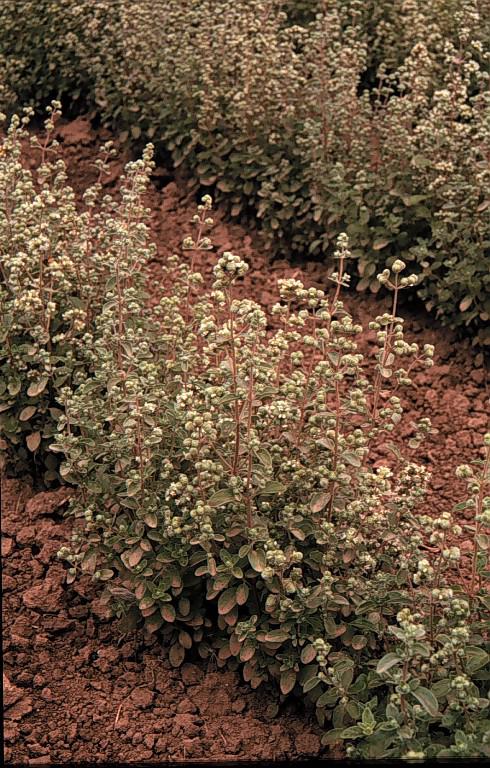
Majorana hortensis is a well-known aromatic plant in Lamiaceae family, synonymous name is Origanum majorana L. Originally, marjoram is a cold-sensitive perennial species, in Hungary it is cultivated as an annual herb (Th). The stems are 25-50 cm tall, branching, the young shoots are greyish. The leaves are oval, haired, the marginals entire and the leafstalks are short. The flowers are small, white or greenish-pink, placed near the globular bracts. The inflorescences are compound, spike-like. The fruits are small, tan brown. Thousand seed weight: 0.22-0.44 g.
Majorana hortensis originates from South-West Asia and North Africa. In Hungary it is known and cultivated since the 16th century, the cultivation area of the plant is the Southern region of Hungary: Kalocsa, Tolna county. Marjoram prefers high temperature, light and wet, nutrient rich soils. The frost tolerance of the plant is very low.
The drug is the crumbled or milled dried flowering shoot of the herb (Majoranae herba). The essential oil distilled from marjoram is also in commercial trade (Majoranae aetheroleum).
Essential oil is the most important active agent of Majorana hortensis, it is accumulated 0.5-1.3 % in the flowering shoots. In the crumbled, purified (the stems are separated) drugs it can reach 2.0-2.5 %. The main compounds of the oil are terpinene, alfa-terpineol, sabinene hydrate. Rosmarinic acid, hydroquinons, flavonoids and bitter substances also accumulate in marjoram.
Majorana hortensis has carminative, analgesic effect, also reduces the distintion of gaster. The essential oil composition is effected by the method of extraction. The distilled marjoram oil has antiseptic, antimicrobal effect. In the folk medicine it is applied for gastric diseases, coughs and externally for curing rheumatism. Most widely the herb is used as a spice.
Matricaria recutita L. - Chamomile
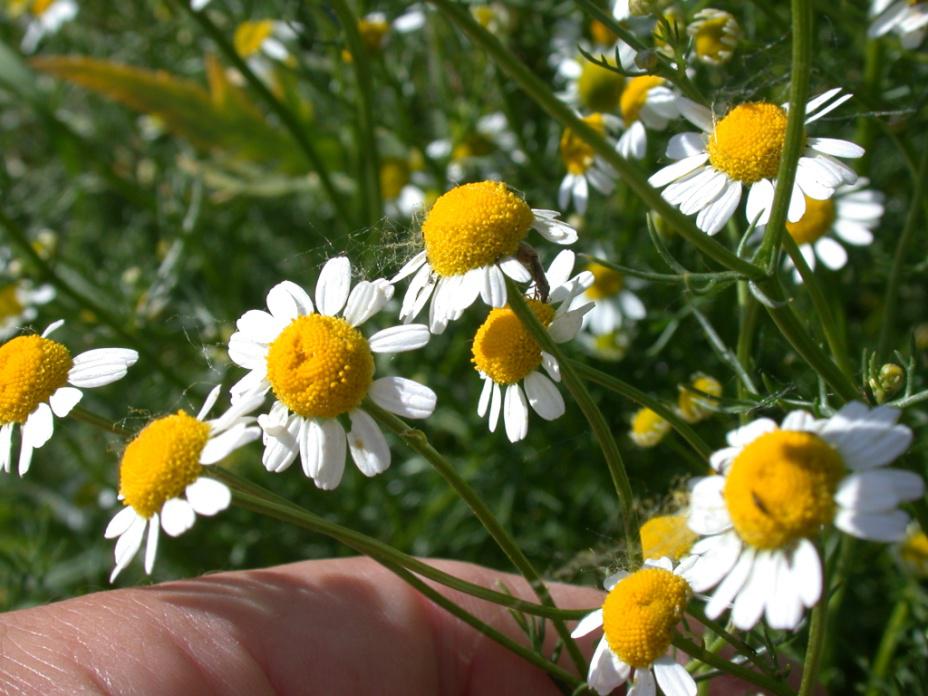
Synonymous Latin names are: Chamomilla recutita (L.) Rausch. and Matricaria chamomilla L. Matricaria recutita is an annual, herbaceous plant in Asteraceae family/ Asteroideae subfamily, often cultivated as biennial (Th-TH). Chamomile has taproot and branched, erect and smooth stem, which grows to a height of 5–80 cm. The leaves are alteranate, long, narrow, bi- or tripinnate. The flowers are borne in terminal, compound flower heads from the end of April to midsummer. The ray florets are white, while the disc florets are yellow. The flower head is 1.5-3.0 cm wide and has a strong, aromatic scent. The receptacle is hollow and swollen. This morphological feature distinguishes chamomile from the valueless Anthemis species. Fruits are 1-1.5 mm long greyish-white achenes, thousand seed weight: 0.02-0.03 g.
Chamomile originates from the Eastern part of Mediterranean Sea, but distributed worldwide on moderate climate as a weed. It is also common in Hungary, mostly on the saline areas of Alföld. Chamomile needs sunlight, even during germination, and prefers high temperature. The frost-tolerance of the species is high at leaf rosette phase.
The dried flowers (Matricariae flos), the essential oil (Matricariae aetheroleum) and the alcoholic extract of the flowers ( Matricariae extractum fluidum) are the drugs of chamomile. The oil can be distilled from the dried or fresh flowers and floral stems. The sifted flowers are also known as Chamomillae cribratum. The drugs are mentioned by Ph. Hg. VIII., ESCOP-, E- and WHO-monographs. Matricariae flos prescribed to contain 4 ml/kg blue essential oil and 0.25 % apigenine-7-glycoside, while Matricariae aetheroleum at least 5 % chamazulene and 15 % alfa-bisabolol.
Chamomile flowers contain 0.4-1.2% essential oil. The blue colour of the oil is caused by the chamazulene content, which compound is forming during the distillation. Further important volatile compounds are: alfa bisabolol and its oxides, bisabolol oxide A and B, beta farnesene. The flower also accumulate fllavonoids (0.3-3.0 %), like apigenin, luteoline, patuletin, pectins (3-17 %), coumarins, phenolic acids, colin and minerals.
Antispasmolytic, analgesic, anti-inflammatory, antibacterial, antifungal, wound healing effects of chamomile are improved. Internally the plant is used for curing the inflammation of gaster and inner epithels, or ulcers. Inhalation with the infusion is also efficient against bronchial problems. Sedative, carminative, digestive effects are also known. Internally, it is applied for healing inflamed eyes, gums and wounds.
Melissa officinalis L. – Lemon balm

Melissa officinalis is a herbaceous, perennial aromatic plant in Lamiaceae family (H). Roots are thin, yellowish-brown, rhizome is wooden. Rhizomes develop several overground stems too. Plant grows to 50-100 cm height, stems are branched. Leaf arrangement is opposite decussate, the leaves have 3-6 cm long stalks, leaf shape is ovate, the marginals are dentate. The leaves are slightly covered with hair, dark-green, vesicular surfaced, and have a pleasant lemon odour. Flowers are compound, white, they bloom during summer, from early July to August. The flowers are filled with nectar, attract bees. Fruits are 1.5-2 mm long, ovate, shiny almost black. Thousand seed weight: 0.6-0.7 g.
Lemon balm is native to South Europe (Eastern coasts of Mediterranean Sea), in Hungary it is cultivated, but several wild populations are known in wooded, dry habitats. The plant prefers warm, sunny places and well drained, calcic soils.
Lemon balm’s drugs are the dried flowering stems (Melissae herba) and the dried leaves (Melissae folium), the latter one is mentioned by Ph.Hg.VIII., ESCOP- and E-monographs. The essential oil distilled from the fresh or dried herb (Melissae aetheroleum) is also an important drug. The high quality drug contains at least 4 % rosmarinic acid, according to the standards.
The overground organs of the plant accumulate essential oil. The volatile oil content is the highest in the leaves, it can reach 0.2-0.5 %. The compounds are: citral, citronellal, geraniol, linalool. Lemon balm also contains phenolic agents: rosmarinic acid and flavonoids (luteoline, quercetin, kaempferol, apigenine).
Lemon balm has sedative effect, internally it is used for sleeping disorders, gastric diseases, nervousness. The water extract of Mellisa officalis has antiviral effect, externally it is applied for curing herpes. The essential oil and the alcoholic extract are used for healing neuralgia, gastric problems.
Mentha x piperita – Peppermint
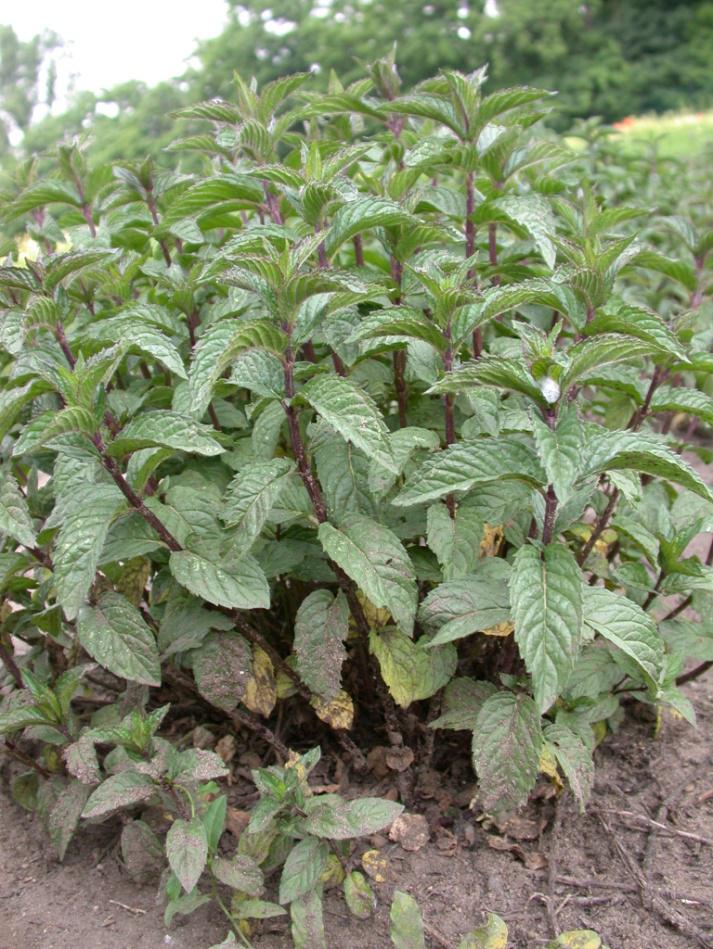
Mentha species belong to the Lamiaceae family. Peppermint is a herbaceous, perennial aromatic plant (H). The thin, 15-20 cm long roots develop from the 3-4 mm wide rhizomes. The plant is overwinter with its stolons. The stolons are branched, white, they can develop both roots and shoots. The plant grows to 30–90 cm tall, with smooth stems, square in cross section. The stems are often red from the accumulated antocyanidine. The leaves are 4–9 cm long and 1.5–4 cm broad, dark green with reddish veins, with an acute tips and serrate margins. Both the leaves and stems are usually slightly hairy. The flowers are purple, borne in spikes. Flowering lasts from mid to late summer. The fruits are small, reddish-brown, usually not viable. Mentha x piperita can be distinguished from the related species easily with their morphological species. Mentha spicata var. crispata doesn’t develop stolons and doesn’t accumulate antocyanidine. Its stems are 40-80 cm tall, light green, the leaves are wavy, dentate. Mentha arvensis var. sachalinensis grows taller than the other species and covered densely with hair.
The speciation of peppermint is caused by the spontaneous hybridization of Mentha aquatica L. and Mentha spicata. The species probably originates from England, but other suppositions are also known. Peppermint grows easily in warm, light places, wet, nutrient-rich soils.
The dried flowering shoots (Menthae piperitae herba), dried leaves (Menthae piperitae folium) and the essential oil, distilled from the fresh shoots (Menthae piperitae aetheroleum), are the drugs of peppermint. They are official in Hungarian Pharmacopoeia and in ESCOP-monographs. According to the standards the essential oil content of Menthae piperitae folium is at least 12 ml/kg.
The main active substance of Mentha x piperita is essential oil: the leaves contain 2-4 %, the flowers 4-6 %, while the stems don’t accumulate oil. The major compounds are menthol (40-60 %), menthone (20-25 %), piperitone (0.1-1.5 %), menthofuran, pinene and sabinene. Rosmarinic acid and flavonoids are also found in the stems.
Peppermint has antispasmolytic, anti-inflammatory, analgesic, antiseptic and cooling effect. Peppermint oil is recommended for treating gastric, gallbladder,bronchial disorders, cough, cold. Externally it is efficient for rheumatic problems, itchiness and hives. The leaves and the oil are important materials of food and cosmetic industry.
Ocimum basilicum L. - Basil

Ocimum basilicum is an annual, herbaceous aromatic plant in (Lamiaceae) family (Th). Originally it is cultivated as a perennial herb in India. Basil has 10-16 cm long taproot. The stems are erect, narrow, 40-60 cm tall, branched. The leaves are opposite decusate, usually green, ovate with long stalks. The flowers borne in compound, loose spikes, they are white or light pink. The blooming starts at the bottom of the spike. The fruits are ovate, dark brown, thousand seed weight: 1.4-1.8 g.
Basil is native to North-West India. It is cultivated in Spain, Turkey, Italy, Egypt, Pakistan, Bulgaria and in Hungary, too. Basil grows easily only warm, sunny places and wet, nutrient-rich soils. In Hungary it is cultivated in Tolna county, Kalocsa area (same with marjoram).
Basilici herba , the dried flowering shoot of the plant is the drug, but the essential oil (Basilici aetheroleum) is also used.
Basil accumulates essential oil, in the overground parts the oil content can reach 0.5-1.5 %. There are several basil types; the differentiation is based on the essential oil composition. In the oil of European basil, which is cultivated in Hungary too, methyl chavicol and linalool are the main compounds. The African type accumulates methyl chavicol and camphor, while Indian basil is rich in methyl chavicol (80-90 %).
Basil has digestive, carminative, appetitive, diuretic effect. As a medicinal and aromatic plant it has been used for a long time. In the folk medicine gastric disorders were treated with the plant. Nowadays teas, tea mixtures are made with the drug for curing coughs, sore throat, loss of appetite, distension. Alcoholic extract of basil is material of mouth and throat irrigations.
Papaver somniferum L. – Poppy
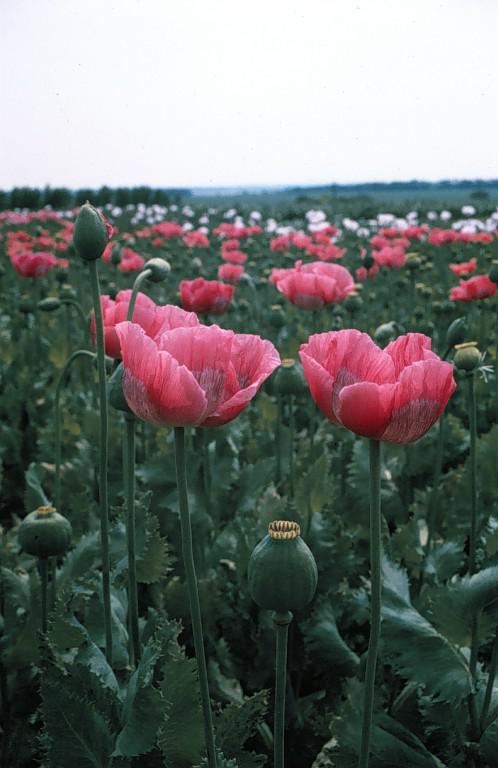
Papaver somniferum is a herbaceous, annual medicinal plant in (Papaveraceae) family (Th). Poppy has 18-20 cm long, wooden taproot with few lateral roots. The stem is erected, 50-150 cm tall, branched on the upper part of the stem. The lower leaves in the rosettes are oblong, elliptic, don’t have stalks. The stem-leaves are alternate, oblong-ovate, the leaf size is smaller on the upper parts of the stem. The flowers are terminal, 6-12 cm diameter, white with darker (purple) patches on the basal part of the petals. The fruit is hollow capsule with compartments. The fruit size and shape is diverse. The seed is also variable, specific to the variety, but usually kidney-shaped, the seed colour differs from white too black. Thousand seed weight: 0.3-0.6 g.
Papaver somniferum has been known for 4000 years, originates from Anatolia. It is also distributed through Europe and cultivated on 80-100 thousand hectares worldwide. In Hungary the cultivation is regulated by the law, the industrial poppy cultivation is coordinated by Alkaloida Vegyészeti Gyár (Tiszavasvári). Two poppy ecotypes are known (and cultivated) in Hungary. „Spring” poppy’s vegetation lasts for 120-160 days, the seed germination is optimal at 7-10 °C, the leaf rosettes frost-tolerance is very low. To the contrary, „autumn” poppy’s growing period is longer (250-270 days), germination optimum is 15-20 °C, and the plants overwinter in leaf rosette phase. Poppy prefers nutrient-rich, neutral soils.
The plant can be utilized in several ways. In India, opium is manufactured from the unripe fruits: after scratching the capsules, the dried latex is collected for further processing. In the Hungarian Pharmacopoeia VIII. the dried, powdered (Pulvis opii) and crude opium (Opium crudum) is described. Nowadays the alkaloids are isolated from the dried capsules (Papaveris caput maturis). The isolation method was elaborated by János Kabay, famous Hungarian pharmacist. Papaveris caput maturis is one of the most important materials of Hungarian pharmaceutical industry. In Europe the consumption of poppy seed is widespread, too.
The main active agents of Papaver somniferum are alkaloids, formed from phenylalanine precursors. The total alkaloid content of the ripe capsules is 0.5-3.5 %, 40 different alkaloids are detected in the plant. The main alkaloids are: a morphine (0.4-2.0 %), codeine (0.3-0.7 %), thebaine (0.4-0.7 %), narcotine (0.3-1.0 %), narkctoline (0.1-0.3 %) and papaverine (0.3-1.0 %). Poppy seed doesn’t accumulate alkaloid, but contains 40-55 % fatty oil and 20-25 % protein.
Poppy alkaloids can be used only in pharmaceutical industry. Morphine has analgesic, euphoric effect, while codeine is applied against coughs and has mild analgesic effect too. The other alkaloids (papaverine, narcotine, thebaine, etc.) are also important medicament materials.
Pimpinella anisum L. – Anise, aniseseed
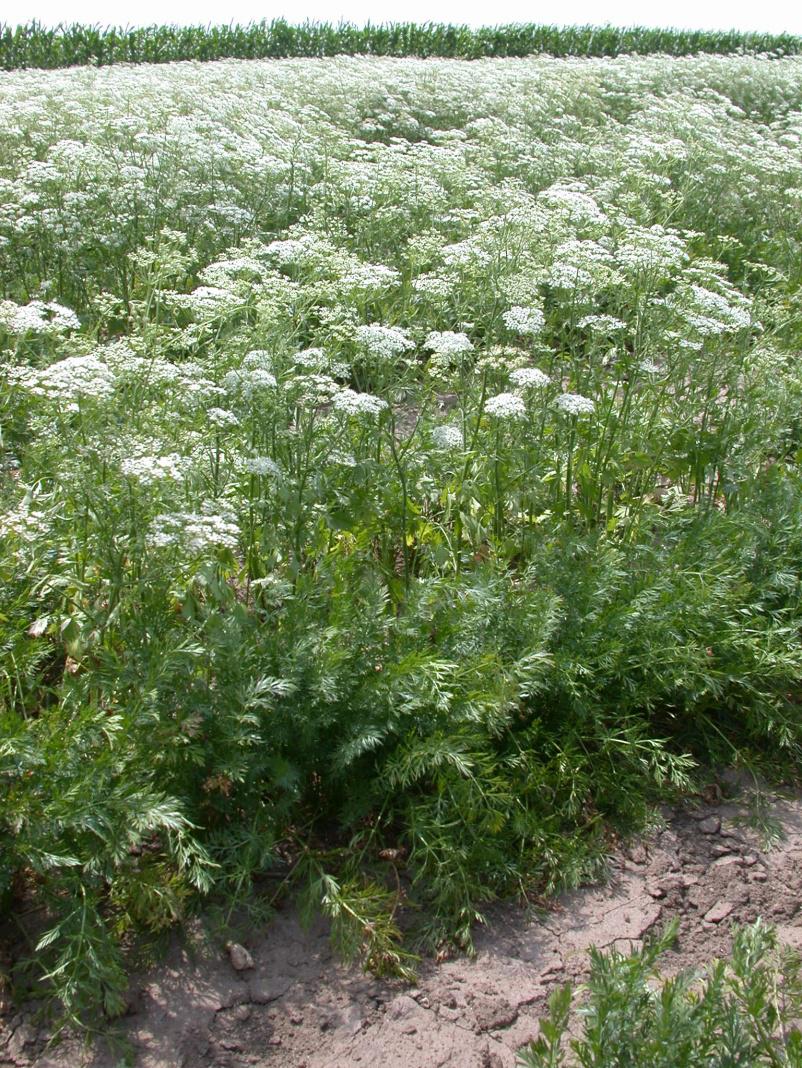
Pimpinella anisum is a herbaceous annual herb in Apiacae family (Th). The root is thin, branched, 20-30 cm long. Anise grows to 30-70 cm tall, the stem is erect, covered with hair slightly. The leaves at the base of the plant are simple, 1-5 cm long and shallowly lobed have long stalks, while leaves higher on the stems are feathery pinnate, divided into numerous leaves. The flowers are white, 3 mm in diameter, produced in dense compound umbels, bloom in July. The fruit is, 3–6 mm long, oblong dry schizocarp. Thousand seed weight: 1.5-4.0 g.
Anise is native to the East Mediterranean, Anatolia and Egypt. As an important aromatic plant it is cultivated in the Southern part of Hungary. Anise plants grow best in light, fertile, well drained soils.
Anise drugs are the dried, ripe fruits (Anisi fructus) and the seed’s distilled essential oil (Anisi aetheroleum) mentioned in Ph.Hg.VIII. and ESCOP-monographs. The seeds have to contain at least 20 ml/kg, according to the standards.
Anise contains essential oil, in the ripe fruits the total oil amount can reach 1.5-6.0 %. The volatile compounds are trans-anethole (80-90 %), methyl chavicol (0.5-6.0 %), alfa-terpineole (0.1-1.5 %), cis-anethole (less than 0.5 %), anisic aldehyde (0.1-3.5 %), anisil ketone, anisic acid, linalool (0.1-1.5 %). The fruits also accumulate flavonol glycosides, phenolic acids, furanocoumarins, hydroxicoumarins, fatty oil 18-23 %), 16-20 % protein and 3-6 % saccharids.
Antibacterial, antifungal, expectorant, antispasmolytic, anti-inflammatory, analgesic and sedative effects of anise are proved. The drug is used as a mild carminative, but also efficient against inflammation of tonsillitis and rheumatism. Anise is used in confectionery, liqueur industry.
Rosmarinus officinalis L. – Rosemary
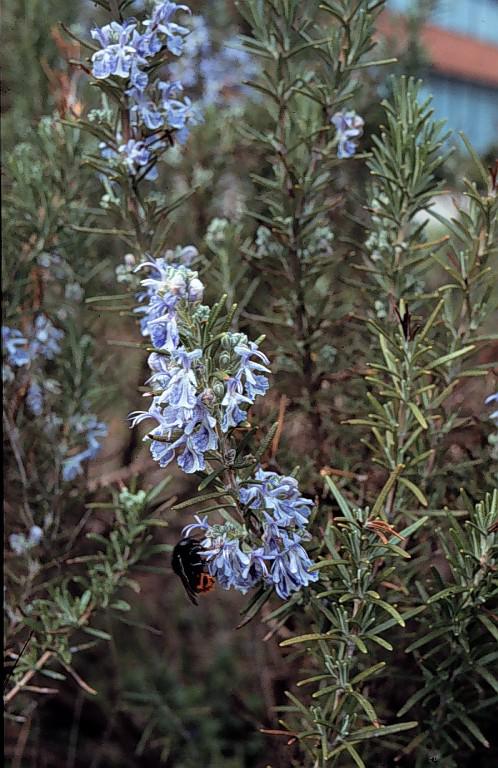
Rosmarinus officinalis is a perennial, evergreen aromatic shrub in Lamiaceae family (N). The height of the plant is 0.5-1.5 m. The root and shoots are branched, wooden. The greyish leaves are narrow, needle-like, 1.5-4 cm long, 2-3 mm wide, with entire margins, they are covered with hair and don’t have stalks on them. The flowers are light blue or white, bloom from March to June. The fruits are light or dark brown, but usually not viable. In Hungary rosemary is propagated vegetatively.
Rosmarinus officinalis originate from the Mediterranean: it is native to Spain, South France, Italy, Dalmatia, Switzerland, Azores Islands, Canary Islands, Madeira, Corsica and North Africa. Rosemary is drought-tolerant, grows well in warm, sunny places. The frost tolerance of the plant is low, in Hungary rosemary only overwinter in protected, warm places.
Rosmarini folium , the dried leaves of rosemary and Rosmarini aethetroleum, the essential oil distilled from the floral shoots, are the official drugs in Ph.Hg.VIII. The standards prescribe 12 ml/kg essential oil in the drug and at least 3 % rosmarinic acid in the oil.
The whole plant accumulate essential oil: the content is the highest in the leaves (1.0-2.5 %), floral shoots contains it in 0.5-1.5 %. Other active substances are tannins, cinnamic acid derivates (mainly rosmarinic acid), flavonoids (apigenin, luteoline and its glycosides), triterpenes and diterpene bitters. The main volatile compounds: 1.8-cineol (13-35 %), camphor (15-25 %), borneol (15 %), bornyl acetate, pinenes, kamphene and linalool.
Rosemary leaves antibacterial, antiviral, antioxidant, antiseptic, antispasmolytic, cholagoge, hepatoprotective, anti-inflammatory, antitumor activities are proved. The infusion of the herb is applied in gastric disorders. Internally, the essential oil is stimulating the blood circulation and effective against rheumatic problems. Rosemary oil is used in cosmetics and in liqueurs as well.
Salvia officinalis L. - Sage

Salvia officinalis is a perennial, evergreen sub-shrub in Lamiaceae family (N). The root is strong, located deep under the soil surface, branched. The stem grows 50-80 cm tall, greyish-brown, wooden, in older plants it is branched. The young stems are cinerary, grey. The leaves are oblong, lanceolate, the lower leaves have stalks, in contrast with the upper located leaves. The leaf margins are crenate, the leaf surface is covered with hair densely. The flowers borne in compound inflorescences, the colour of the petals differ from purple, light blue to white or pink. The flowering time lasts from the end of May, to middle July. The fruits are globular, dark brown with white patch on them. Thousand seed weight is: 7.6-7.8 g.
Several subspecies are known. A Salvia officinalis subsp. lavandulifolia (Vahl.) Cuatr. has narrow, lanceolate leaves, its essential oil is free of thujone. Salvia officinalis subsp. minor Gams. has bigger, stalkless leaves (4-7 cm long, and 1-2 cm wide). Salvia officinalis subsp. major (syn. officinalis) Gams is stronger growing, with 5-10 cm long, 2-5 cm wide and hairy leaves.
Salvia officinalis is a Mediterranean plant, originates from the Northern coast of Mediterranean Sea. It grows well on warm, calcic soils. The drought tolerance of the plant is high.
The dried, whole or cut leaves, known as Salviae officinalis folium, are the drug of sage. It is described in Ph.Hg.VIII., ESCOP- and E-monographs: the minimum essential oil content is 15 ml/kg, in cut drug 10 ml/kg.
Sage contains 1-2.5 % essential oil, with alfa- and beta- thujone (30-50 %), borneol (6-14 %), cineol (10-15 %), camphor (6-10 %) and pinene (1-2 %) as main compounds. The daily consumption of sage drug is strictly limited, because of the carcinogen activity of thujone. The plant accumulates diterpenes, triterpenes, tannins (3-8 %) flavonoids (1-3 %), rosmarinic-, caffeic acid and phenolgylcosides too.
Sage drug has anti-inflammatory, bactericidal and antiviral activity. It is also efficient against abnormal perspiration, caused by increased thyroid activity or unbalanced nervous system. In folk medicine sage leaf was used for reduce bleeding (astringent activity), increase biliary excretion and relieve spasms.
Silybum marianum (L.) Gaertn. – Milk thistle
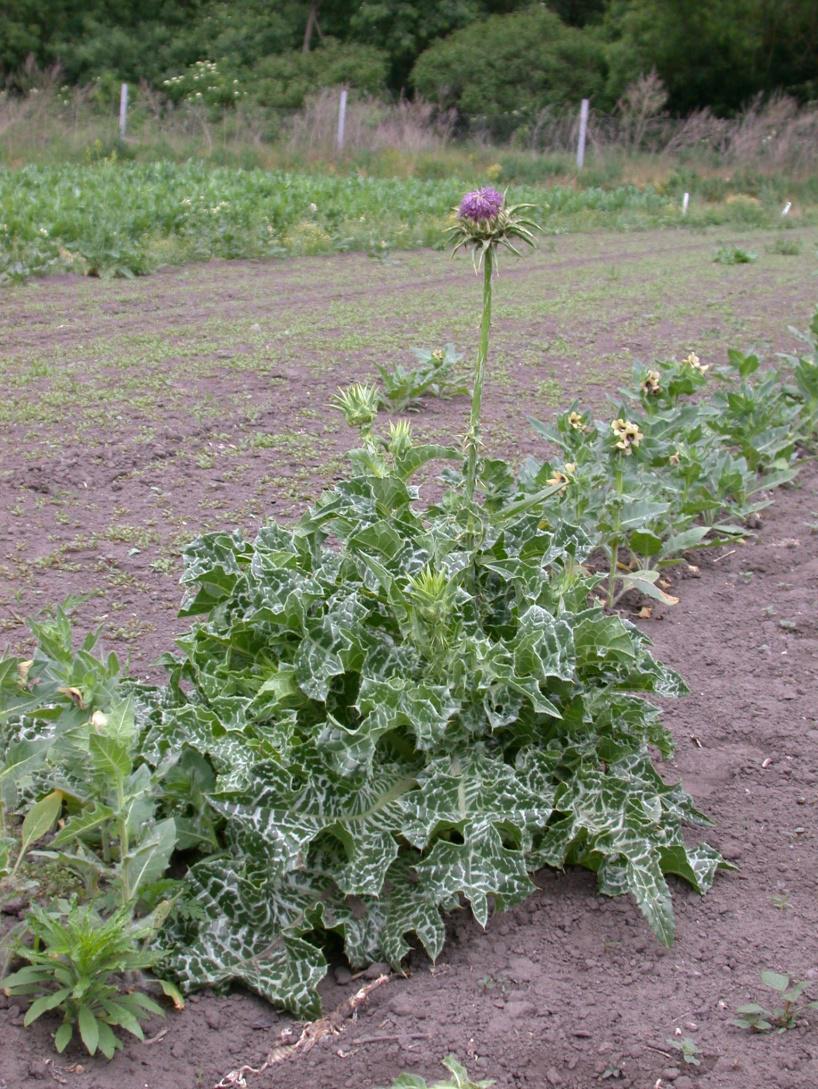
Silybum marianum is herbaceous, annual medicinal plant in Asteraceae family/ Carduoideae subfamily (Th). Milk thistle has taproot, the stem is erect, often branched 1.5-2.5 m tall. The stark leaves stand in a big leaf rosette, they are stalkless, oblong-elliptic, pinnatifid, the margins are thorny. The leaf surface is hairless, shiny with milk-white veins. The flower heads are 5-8 cm wide, ovate, thorny, purple or sometimes white colour. The flowering time lasts from June to July. Milk thistle’s fruit is oblong-ovate, brown achne with topknot on it. Thousand seed weight: 22-31 g.
Originally Silybum marianum is native to South Mediterranean, now it is distributed throughout the world. In Central Europe and Hungary, the plant is also intensively cultivated. Milk thistle prefers warm, sunny places, grows well on almost every soil types.
The ripe fruit (Silybi mariani fructus) of milk thistle is described in Hungarian Pharmacopoeia VIII. ESCOP- and E-monographs also mention the drug as Cardui mariae fructus (Milk Thistle Fruit). The standards require at least 1.5 % silybinin (silybin) in the fruits.
The therapeutic effect of milk thistle is caused by the flavonolignanes of the fruit pericarp. This substances occur in 1.5-3.0 %, and known as silymarin complex (silybinin, silydianin, silychristin). The drug contains flavonoids (taxifolin, quercetin, kaempferol, apigenin), fatty oil (20-25 %), sterols, mucus too.
The active substances of Silybum have anti-inflammatory, antioxidant, radical-scavenging, hepatoprotective activity. The mebrane lipid stabilisation effect is also proved. It is used in cases of liver diseases (cirrhosis, hepatitis) and claimed to protect the liver against poisons. In folk medicine it was used for healing jaundrice and increase lactation.
Sinapis alba L. – White mustard
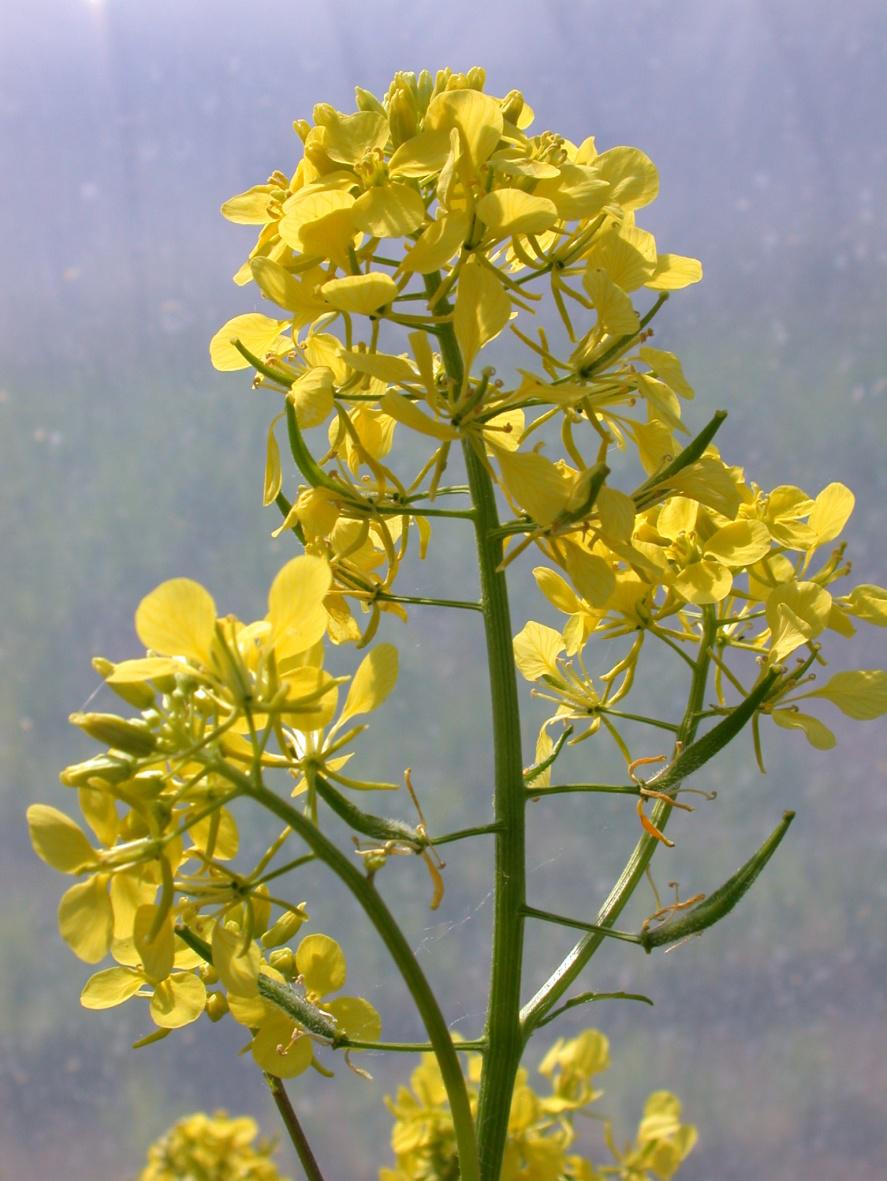
Mustards species are annual, herbaceous plants, belonging to Brassicaceae family (Th). White mustard’s synonymous names are Brassica alba and B. hirta. It grows 50-80 cm tall, and has thin taproot. The leaf arrangement is alternate, the leaves are pinnatifid, stalked. The stem and the leaves are covered with hair. The yellow flowers bloom in racemes. The fruit is swollen, hairy, 3-4mm wide, 2-4 cm long, perpendicular to the flower stem. The fruit contains 3-6 yellow, globular seed 2-3 mm in diameter. Thousand seed weight: 4-8 g.
The other cultivated mustard species can be differentiated by hairiness, fruit and seed morphology. Indian mustard (Brassica x juncea) has smooth stems, the fruits are often reddish from the accumulated anthocyanin and they stand in 30-40 ° compared to the stem. The seeds are reddish-brown. Black mustard’s (Brassica nigra) fruits are shorter, flatted on the stem. The seeds are small, dark-brown or black.
Sinapis alba originates from the Mediterranean region, West Asia. Mustard species are known since antiquity, to Europe they were carried by Arabians. Nowadays mustard species are cultivated throughout the world.
White mustard drug is the seed: Sinapis albae semen.
Sinapis albae seeds contain mustard glycosides -which are contain nitrogen or sulphur- such as allyl isothyocyanate (sinalbin). These glycosides are decomposing to allyl mustard oil (0.5-1.7 %) in presence of water and myrosin enzyme (in saliva). This chemical reaction causes the pungent taste and smell of mustard. The seed accumulates essential oil (0.2-1.0 %), fatty oil (30-40 %), mucus, protein (40 %) and phenil-propane derivates (sinapin) too. The plant contains toxic agents, such as erucic acid.
Mustard seed is an important spice, used by the food industry, known and popular worldwide. Internally, consumed as spice, mustard has appetitive effect. Externally, mustard pulp increases blood circulation, causes local plethora and relives pain.
Thymus vulgaris L. - Thyme

Thymus vulgaris is a low growing sub-shrub in Lamiaceae family (Ch). The roots and lower shoots are wooden, the stems are erect, 20-50 cm tall. The small, lanceolate leaves are opposite decusate, dark-green. The marginals are entire, wrapped. The flowers bloom from May to June, the flower colour differs from white to pink or light-purple. The seeds are very small, dark-brown, thousand seed weight: 0.25-0.28 g.
Thymus vulgaris is a characteristic Mediterranean species, originates from the North-West coasts of Mediterranean Sea. In Hungary, thyme is not native, but often planted in gardens and sometimes occurs wildly on calcic, well drained soils in warm, sunny places.
Thyme’s drug, which is official in Hungarian Pharmacopoeia VIII. is Thymi herba. The drug consists of the dried flowering shoots (the stems are separated) of Thymus vulgaris or T. zygis, or both species. Pharmacopoeia describes 12 ml/kg essential oil content with 40 % phenolic monoterpene in the drug. The volatile oil of thyme is also important, Thymi aetheroleum. The oil is prescribed to be distilled from the fresh, overground parts of Thymus vulgaris, T. zygis, or both of them. Herba and aetheroleum are mentioned in ESCOP-, E- és WHO-monographs too.
Thyme’s most important active agent is essential oil, the amount is 1.0-2.5 %, the major constituent is thymol (20-75%). P-cimol, gamma terpinene, geraniol, linalool, alfa-terpineol, carvacrol and thujanol can be main compound too. The herb contains cinnamic acid derivates (rosmarinic acid, caffeic acid, chlorogenic acid, coumaric acid, ferulic acid), flavonoids (apigenin, luteolin and their glycosides) and triterpenes (ursoic acid, oleanolic acid).
Thymi herba has strong antibacterial, antiviral, antifungal, antioxidant and spasmolytic activity. Thyme infusion is one of the most frequently used antisepticums and spasmolyticums against bronchial diseases. The herb has effect on gastric organs too: digestive, carminative, and anthelmintic. The alcoholic extract is used against skin fungus. Fragrance and liqueur industry uses Thymus essential oil. Last, but not the least, Thymi herba is one of the most important spices of Mediterranean cuisine.
Valeriana officinalis L. - Valerian
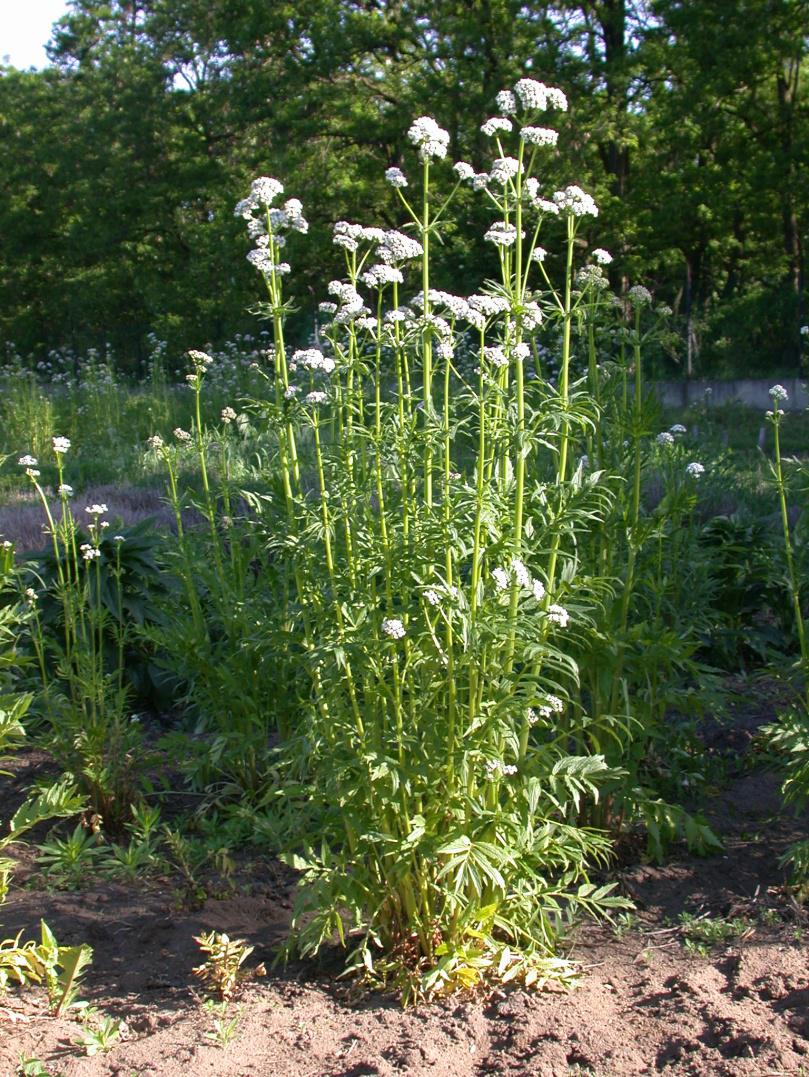
Valeriana officinalis is a herbaceous, perennial medicinal plant in Valerianaceae family (H). In the first vegetation year only the leaf rosettes grow, from the second year the flowering stems also appear. The rhizomes are short, cylindrical with several spindle-shaped, white lateral root (15-20 cm long, 2-5 mm thick). The stem is erect, it can reach 140-200 cm, hollow, striated, on the upper parts branched. The leaves are odd-pinnate, serrate, on the lower parts of the plant has long leafstalks, on the upper parts has shorter stalks. The inflorescence is terminal, branching umbel-like. The flowers are white or pink with a pleasant odour. The fruit is small, drop-shaped, light-brown achne with topknot. Thousand seed weight: 0.5-0.6 g.
Valerian is native to Europe and parts of Asia, in Hungary it grows wildly too. The seeds need light during the germination. For the best yields valerian needs lot water and nutrient-rich, well drained soil.
The drug (Valerianae radix) consists of the cleaned and dried rhizome and root of the herb (Ph.Hg.VIII., ESCOP-monograph). As it is prescribed, the whole drug contains 4 ml/kg essential oil, 0.17 % valerenic acid, while the cut drug contains 3 ml/kg essential oil and 10 % valerenic acid.
Valerian drug contains 0.4-0.6 % essential oil (mainly with monoterpene compounds, such as borneol and sesquiterpene ketones, acids), valepotriates (0.5-1.5 %) and further sequiterpenes (valerenic acid, hydroxi, acetoxi valerenic acid, valerenal, valeranon).
The active agents of the herb have sedative, spasmolytic effect. The drug is consumed in form of teas, tea-mixtures, combined with lemon balm, hop. Valerian is used for sleeping disorders, restlessness and anxiety, and as a muscle relaxant. The volatile oil, distilled from the roots is also applied. In rare cases, valerian may cause an allergic reaction, typically as a skin rash, hives, or difficult breathing.
Verbascum phlomoides L. - Mullein
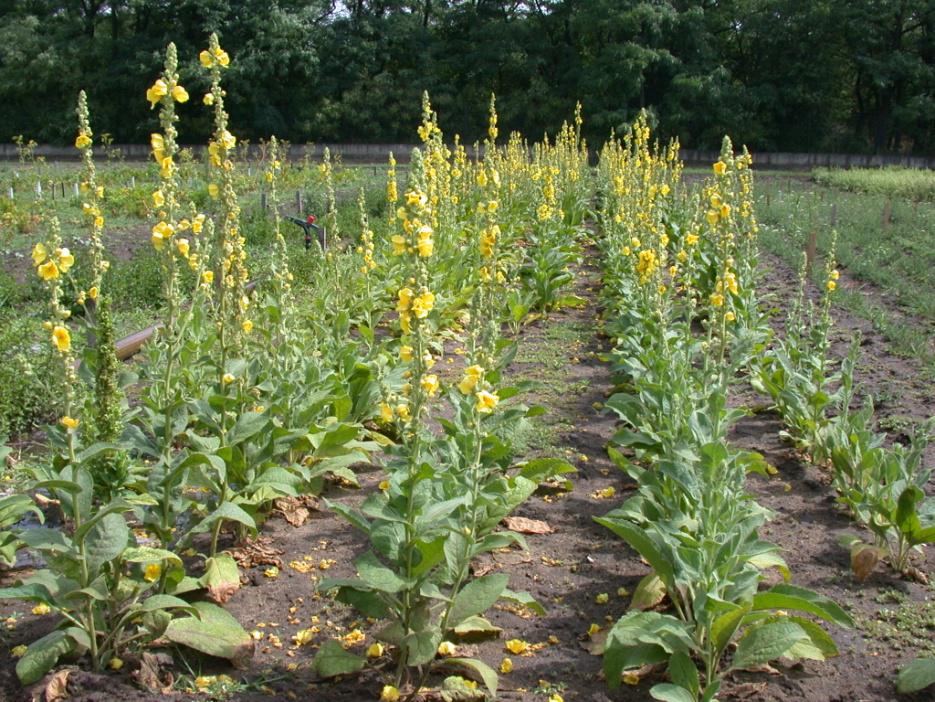
Verbascum phlomoides is a biennial (sometimes annual), herbaceous plant in Scrophulariaceae family (TH-Th). The root is thick, not branched. In the first year of vegetation only the leaf rosettes develop. The leaves are 20-30 cm long, lanceolate, the marginals are crenate. The flower stem develops in the second year, it is 1.5-2.0 m tall, covered with hair. The leaf arrangement is alternate on the stems. The inflorescences are decorative, terminal spikes, the florets are yellow. The flowering starts in June and lasts till August. The flowers are blooming in early dawn. The fruits are capsules with lot, brown seeds in it. Thousand seed weight: 0.08-0.80 g.
Verbascum phlomoides is a cosmopolitan plant species, distributed through Anatolia, North Africa, North America, Europe. In Hungary, it is common in oak forests, pastures, often as a weed. Mullein needs lot light; otherwise it is drought-, and cold tolerant.
Official drug of mullein is Verbasci flos, which consists of the dried petals and the unseparated stamens. Both are mentioned in Ph.Hg.VIII. and in E-monographs, according to the prescribes not only Verbascum phlomoides, but Verbascum thapsus L. and Verbascum densiflorum Bertol. can be collected, too. Mullein leaf (Verbasci folium) is also known and used as herbal drug.
Mullein’s main active agents are polysaccharid mucus (3 %) and its derivatives, flavonoids (1.5-4.0 %), caffeic acid derivates, saponins (verbascogen), saccharids (10-11 %), iridoid-monoterpenes (aucubine) and carotinoids (erocetin).
Mullein drug has antiviral, antibacterial, expectorant activity. It is applied in teas, tea mixtures for healing cold, sore throat, catarrh.
